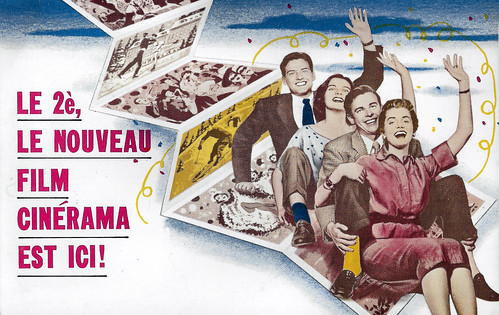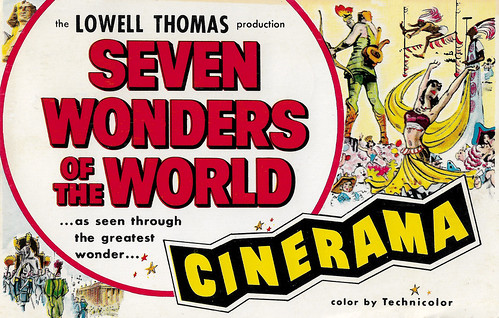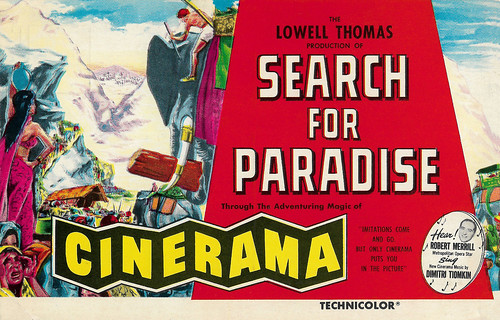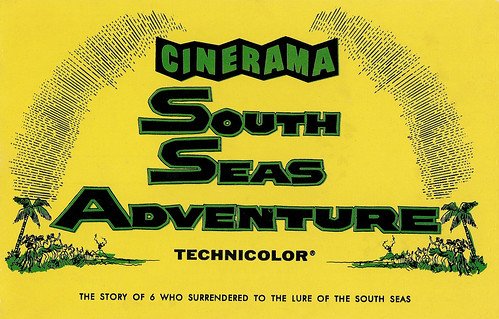
American postcard by Shorecolor New York, circa 1952. Caption: "The biggest new entertainment event of the year."- LIFE. Collection: Amsterdam Eye Filmmuseum.

American postcard by Mitock & Sons, North Hollywood, California. Color by Bert Kaltman / Plastichrome, Boston. The picture was taken at the premiere of It's a Mad Mad Mad Mad World (1963, Stanley Kramer). This postcard was sent from Mexico to Italy (We bought it in the USA and it's now in our collection in the Netherlands). Pacific's Cinerama Theatre is "The Only Theatre Of Its Kind In The World", boasts the card's publisher at the backside of the card. "Located in Cinerama Center, Sunset and Ivar, Hollywood, it's the first geodesic dome in concrete anywhere in the world. It is the first major theatre built in Hollywood in 35 years. It is an endless network of electronic marvels. Gold is the dominant color in the richly fabricated carpeting and drapes. Striking innovations in lightning and luxurious seating provide unbelievable comfort and beauty."

Canadian postcard by Desbarats Printing Co. LTD., Montréal. Caption: I'm having a wonderful "Cinerama Holiday".
You are in the middle of it
Cinerama was designed to give the viewer the sensation of physically experiencing the film by surrounding him with images and sound. "You are in the middle of it," was the slogan. Looking at the centre of the colossal screen, the spectator's entire field of vision was filled with images. The 7-channel stereo sound of unprecedented quality at the time heightened the suggestion of reality experience even more.
Cinerama films were shown like plays, with reserved seats in the cinema and paper programmes handed out, and audience members often dressed in their best attire for the evening. The Cinerama concept was originally intended to let the viewer take a trip around the world in their armchair, experiencing adventures that most of them would never experience in reality, especially in the 1950s, when world travel and flying holidays were still far off in the future.
The first seven Cinerama films were therefore not feature films, but sequences of fascinating shots of exotic places, shots from an aeroplane over mountain landscapes, from the trolley in a roller coaster, from a rubber boat over a rapid in a wildly swirling river, or from a gondola in Venice, as well as from a lodge at the Scala in Milan during a performance of the opera 'Aida'. This original Cinerama 3-panel, as the trade term goes, was used for 11 years, from 1952 to 1963, and was initially very successful.
The first Cinerama film, This Is Cinerama (Mike Todd, Michael Todd, Jr., Walter A. Thompson, Fred Rickey, 1952), premiered on 30 September 1952 at the Broadway Theatre in New York City. The New York Times judged it to be front-page news. Certainly, the first films attracted packed theatres for years. This diminished when the novelty wore off a bit, but months of prolongations were still common.
Seven official Cinerama 3 panel films were made, the last two of which were feature films. Consecutively, This is Cinerama (Mike Todd, Michael Todd, Jr., Walter A. Thompson, Fred Rickey, 1952), Cinerama Holiday (Robert L. Bendick, Philippe De Lacy, 1955), Seven Wonders of the World (Tay Garnett, Paul Mantz, Andrew Marton, Ted Tetzlaff, Walter Thompson, 1956), Search for Paradise (Otto Lang, 1957), South Seas Adventure (Carl Dudley (final segment), Richard Goldstone, Francis D. Lyon (first segment), Walter Thompson (second segment) and Basil Wrangell, 1958) and the feature films How the West Was Won (John Ford, Henry Hathaway, George Marshall, 1962) and The Wonderful World of the Brothers Grimm (Henry Levin, Geortge Pal, 1962). Although this film system is difficult to lend itself to feature films, the epic Western How The West Was Won (1962) was still quite successful.

American postcard by Capitol Theatre, Cincinnati, Ohio, to promote Cinerama and the film Seven Wonders of the World (Tay Garnett, Paul Mantz, Andrew Marton, Ted Tetzlaff, Walter Thompson, 1956). Caption: Capitol Theatre, Exclusive Cincinnati Home of Cinerama.

American postcard by Warner Theatre, Washington, D.C., to promote Cinerama and the film Search for Paradise (Otto Lang, 1957). Caption: Warner Theatre, Exclusive Washington, D.C. Home of Cinerama.
Five operators simultaneously
Cinerama 3-panel had considerable disadvantages. First of all, it was only usable in very large, hence costly movie theatres, which were hardly suitable for normal cinema films because of the auditorium construction. Moreover, Cinerama cinemas were dependent on only one supplier for their films, and the latter was unable to constantly supply enough new films. Shooting with the leaden and bulky Cinerama camera was complicated, and operating Cinerama theatres was extremely complicated and costly. A film screening in a normal cinema at the time required two projectionists working simultaneously, but a Cinerama screening required as many as five operators simultaneously.
Moreover, in its heyday, there were very few Cinerama theatres, only in a few major world cities. And Cinerama films could only be shown there and generate revenue. With rising labour costs, gradually declining attendance, and a lack of suitable films, the Cinerama 3-panel became too complicated and expensive to operate in the early 1960s. In 1963, Cinerama, therefore, switched to a surrogate, somewhat bombastically called Super-Cinerama, which required only a single 70mm camera, and a 70mm projector, with the 70mm system for large projection screens existing at the time. The existing, highly curved and enormously large, louvred Cinerama screen remained in use. An additional advantage of Super-Cinerama was the absence of the two image separations of the 3-panel Cinerama.
Because 70mm projection was originally made for only slightly-curved projection screens, and far left and far right image distortion would occur on a highly curved Cinerama screen, the first five Super-Cinerama films were released on special optically corrected 70mm film copies. The Super-Cinerama corrected projection system included five films: the comedy It's a Mad, Mad, Mad, Mad World (Stanley Kramer, 1963), The Greatest Story Ever Told (George Stevens, 1965), the Western mockumentary spoof The Hallelujah Trail (John Sturges, 1965), the war epic Battle of the Bulge (Ken Annakin, 1965) and the British war epic Khartoum (Basil Dearden, 1966).
On Cinerama screens, this corrected Cinerama projection system performed relatively well. The big disadvantage, however, was that such corrected films were unsuitable for normal 70mm cinemas. There, the audience saw a corrected image on the slightly curved screen that showed disturbing compressed image distortion at the left and right picture edges. So with good reason, Super-Cinerama films could only be shown in the relatively few Cinerama theatres, and not in the larger numbers of normal 70mm cinemas. Although the latter happened anyway, of course, by omitting the distorted picture edges on the left and right (which is also done when a widescreen film is broadcast on the old 3-by-4 TV screen).
Forced by this circumstance, the Cinerama company, therefore, decided after a few years to release all subsequent Cinerama films on uncorrected normal 70mm film copies. The image distortion in Cinerama theatres was of necessity taken for granted, but these films could henceforth be shown in all 70mm cinemas without any problems. Cinerama films thus produced are Circus World (Henry Hathaway, 1964), 2001: A Space Odyssey (Stanley Kubrick, 1968), Grand Prix (John Frankenheimer, 1966), Ice Station Zebra (John Sturges, 1968), Custer of the West (Robert Siodmak, 1967) and Krakatoa, East of Java (Bernard L. Kowalski, 1968). 70mm films originally intended for Cinerama such as MacKenna's Gold (J. Lee Thompson, 1969), Song of Norway (Andrew L. Stone, 1970) and The Last Valley (James Clavell, 1971) were even released without the Cinerama label. In desperation, the Cinerama company continued producing regular 35mm films for several more years. Nowadays, two Cinerama 3-panel theatres are still in operation as far as we know: Cinerama in Seattle, USA, and Pictureville Cinema, part of the National Media Museum in Bradford, UK.

American postcard by Warner Hollywood Theatre, Hollywood, Calif., to promote Cinerama and the film South Seas Adventure (Carl Dudley (final segment), Richard Goldstone, Francis D. Lyon (first segment), Walter Thompson (second segment), Basil Wrangell, 1958). Captions: The story of 6 who surrendered to the lure of the South Seas. Warner Hollywood Theatre, Exclusive Southern California Home of Cinerama.

American postcard by Martin Cinerama, St. Louis, Missouri, to promote Cinerama and the film Circus World (Henry Hathaway, 1964).

Vintage Dutch postcard. Publicity for the opening (1960) of the Rotterdam Cinerama theatre at Westblaak 18, announced as '...een machtig schouwspel' [ a might spectacle]. The cinema was operated by Cinerama Exhibitors Nederland BV and Holland Exhibitors between 1960 and 1993. In the later 1990s, it was exploited by Pathé, who still owns the building. Today, it is still functioning as cinema and is exploited by the Kinepolis Group. The Rotterdam Cinerama was the first in the Netherlands. In 1965 a second Cinerama theatre opened in Amsterdam as Bellevue Cinerama, which closed in 2005.
Sources: Wikipedia (Dutch), IMDb and postcards.
No comments:
Post a Comment